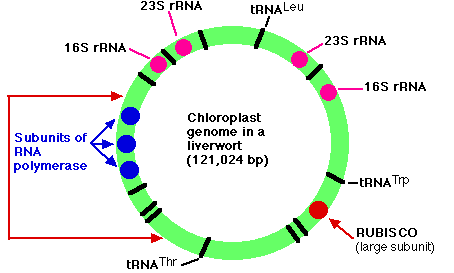Endosymbiosis and The Origin of Eukaryotes
The endosymbiosis theory postulates that
- The mitochondria of eukaryotes evolved from aerobic bacteria (prokaryotes) living within their host cell.
- The chloroplasts of eukaryotes evolved from endosymbiotic cyanobacteria or prochlorophyta (both autotrophic prokaryotes).
- Eukaryotic cilia and flagella may have arisen from endosymbiotic spirochetes. The basal bodies from which eukaryotic cilia and flagella develop would have been able to create the mitotic spindle and thus made mitosis possible.
The evidence for mitochondria and chloroplasts
- Both mitochondria and chloroplasts can arise only from preexisting mitochondria and chloroplasts. They cannot be formed in a cell that lacks them because nuclear genes encode only some of the proteins of which they are made.
- Both mitochondria and chloroplasts have their own genome and it resembles that of prokaryotes not that of the nuclear genome.
- Both genomes consist of a single circular molecule of DNA.
- There are no histones associated with the DNA.
- Both mitochondria and chloroplasts have their own protein-synthesizing machinery, and it resembles that of prokaryotes not that found in the cytoplasm of eukaryotes.
- Their ribosomal RNA (rRNA) and the structure of their ribosomes resemble those of prokaryotes, not eukaryotes.
- The first amino acid of their transcripts is always fMet as it is in bacteria (not methionine [Met] that is the first amino acid in eukaryotic proteins).
- A number of antibiotics (e.g., streptomycin) that act by blocking protein synthesis in bacteria also block protein synthesis within mitochondria and chloroplasts. They do not interfere with protein synthesis in the cytoplasm of the eukaryotes.
- Conversely, inhibitors (e.g., diphtheria toxin) of protein synthesis by eukaryotic ribosomes do not - sensibly enough - have any effect on bacterial protein synthesis nor on protein synthesis within mitochondria and chloroplasts.
- The antibiotic rifampicin, which inhibits the RNA polymerase of bacteria, also inhibits the RNA polymerase within mitochondria. It has no such effect on the RNA polymerase within the eukaryotic nucleus.

The Mitochondrial Genome
The genome of human mitochondria contains 16,569 base pairs of DNA organized in a closed circle.
These encode:
- 2 ribosomal RNA (rRNA) molecules
- 22 transfer RNA (tRNA) molecules (shown in the figure as yellow bars; two of them labeled)
- 13 polypeptides
The 13 polypeptides participate in building several protein complexes embedded in the inner mitochondrial membrane.
All these gene products are used within the mitochondrion, but the mitochondrion also needs proteins encoded by nuclear genes. These proteins (e.g., cytochrome c and the RNA and DNA polymerases used within the mitochondrion) are synthesized in the cytosol and then imported into the mitochondrion.
The genome of the chloroplasts found in Marchantia polymorpha (a liverwort, one of the Bryophyta) contains 121,024 base pairs in a closed circle.
These make up some 128 genes which include:

- duplicate genes encoding each of the four subunits (23S, 16S, 4.5S, and 5S) of the ribosomal RNA (rRNA) used by the chloroplast
- 37 genes encoding all the transfer RNA (tRNA) molecules used for translation within the chloroplast. Some of these are represented in the figure by black bars (a few of which are labeled).
- 4 genes encoding some of the subunits of the RNA polymerase used for transcription within the chloroplast (3 of them shown in blue)
- a gene encoding the large subunit of the enzyme RUBISCO (ribulose bisphosphate carboxylase oxygenase)
- 9 genes for components of photosystems I and II
- 6 genes encoding parts of the chloroplast ATP synthase
- genes for 19 of the ~60 proteins used to construct the chloroplast ribosome
All these gene products are used within the chloroplast, but all the chloroplast structures also depend on proteins
- encoded by nuclear genes
- translated in the cytosol, and
- imported into the chloroplast.
RUBISCO, for example, the enzyme that adds CO2 to ribulose bisphosphate to start the Calvin cycle, consists of multiple copies of two subunits:
- a large one encoded in the chloroplast genome and synthesized within the chloroplast, and
- a small subunit encoded in the nuclear genome and synthesized by ribosomes in the cytosol. The small subunit must then be imported into the chloroplast.
The arrangement of genes shown in the figure is found not only in the Bryophytes (mosses and liverworts) but also in the lycopsids (e.g., Lycopodium and Selaginella). In all other plants, however, the portion of DNA bracketed by the red arrows on the left is inverted. The same genes are present but in inverted order. The figure is based on the work of Ohyama, K., et al., Nature, 322:572, 7 Aug 1986; and Linda A. Raubeson and R. K. Jansen, Science, 255:1697, 27 March 1992.
27 May 1999

